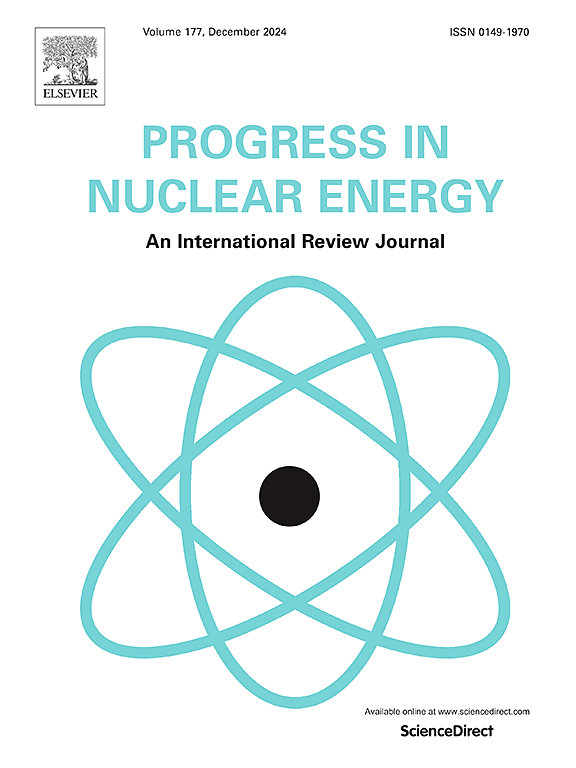An investigation of the long-term deposition of graphite dust particles on turbine blades by mesh-deformation method
IF 3.2
3区 工程技术
Q1 NUCLEAR SCIENCE & TECHNOLOGY
引用次数: 0
Abstract
The persistent accumulation of radioactive graphite particulates on turbine surfaces presents a critical operational challenge for high-temperature gas-cooled reactor (HTGR) systems. This investigation employs high-fidelity numerical simulations integrating discrete phase modeling with mesh deformation methods to systematically examine particulate deposition dynamics and their subsequent impact on turbine cooling effectiveness. A comprehensive deposition framework accounting for multiphase particle-wall interactions (elastic rebound, adhesion, multilayer stacking, and shear-induced resuspension) was established, complemented by the development of predictive model for accumulated deposition mass. Computational results reveal a non-monotonic relationship between particle size and deposition: sub-5μm particulates exhibit extensive deposition patterns primarily driven by adhesion forces, while larger particles are more likely to undergo resuspension due to drag forces. Elevated blowing ratios (M = 2.0) were found to reduce deposition rates by 7–22 %. Lower deposition height enhances the effectiveness of film cooling, while higher deposition height suppresses it. However, overall, the influence of deposition on cooling is limited. The developed predictive model for maximum accumulated deposition mass exhibits good predictive performance (R2 = 0.99), and elucidates the influence of key parameters of particles and film cooling. This study reveals the long-term deposition behavior of particles on turbine blades and provides valuable insights for the safety analysis of HTGRs.
用网格变形法研究了石墨粉尘颗粒在涡轮叶片上的长期沉积
放射性石墨颗粒在涡轮表面的持续积累对高温气冷堆(HTGR)系统的运行提出了一个关键的挑战。本研究采用高保真数值模拟,结合离散相建模和网格变形方法,系统地研究了颗粒沉积动力学及其对涡轮冷却效率的后续影响。建立了考虑多相颗粒-壁相互作用(弹性回弹、粘附、多层堆叠和剪切诱导重悬浮)的综合沉积框架,并建立了累积沉积质量的预测模型。计算结果表明,颗粒大小与沉积之间存在非单调关系:5μm以下的颗粒主要受粘附力驱动,而较大的颗粒则更容易受到阻力的影响而发生再悬浮。提高吹气比(M = 2.0)可使沉积速率降低7 - 22%。较低的沉积高度提高了气膜冷却效果,而较高的沉积高度则抑制了气膜冷却效果。然而,总的来说,沉积对冷却的影响是有限的。所建立的最大累积沉积质量预测模型具有良好的预测性能(R2 = 0.99),并阐明了颗粒和膜冷却等关键参数对最大累积沉积质量的影响。该研究揭示了颗粒在涡轮叶片上的长期沉积行为,为htgr的安全性分析提供了有价值的见解。
本文章由计算机程序翻译,如有差异,请以英文原文为准。
求助全文
约1分钟内获得全文
求助全文
来源期刊

Progress in Nuclear Energy
工程技术-核科学技术
CiteScore
5.30
自引率
14.80%
发文量
331
审稿时长
3.5 months
期刊介绍:
Progress in Nuclear Energy is an international review journal covering all aspects of nuclear science and engineering. In keeping with the maturity of nuclear power, articles on safety, siting and environmental problems are encouraged, as are those associated with economics and fuel management. However, basic physics and engineering will remain an important aspect of the editorial policy. Articles published are either of a review nature or present new material in more depth. They are aimed at researchers and technically-oriented managers working in the nuclear energy field.
Please note the following:
1) PNE seeks high quality research papers which are medium to long in length. Short research papers should be submitted to the journal Annals in Nuclear Energy.
2) PNE reserves the right to reject papers which are based solely on routine application of computer codes used to produce reactor designs or explain existing reactor phenomena. Such papers, although worthy, are best left as laboratory reports whereas Progress in Nuclear Energy seeks papers of originality, which are archival in nature, in the fields of mathematical and experimental nuclear technology, including fission, fusion (blanket physics, radiation damage), safety, materials aspects, economics, etc.
3) Review papers, which may occasionally be invited, are particularly sought by the journal in these fields.
 求助内容:
求助内容: 应助结果提醒方式:
应助结果提醒方式:


